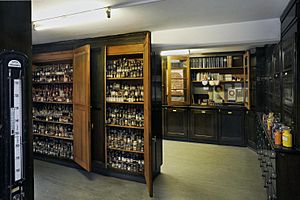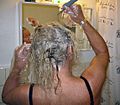Dye facts for kids
A dye is a special substance used to give colour to different materials. It's often used to color the fabric that makes our clothing. Unlike a pigment, a dye can stick to the fibres of the fabric and truly change their color. Dyes can be natural, meaning they come from things like plants or berries, or they can be artificial, which means they are made by people using chemicals.
Contents
Natural Dyes: Colors from Nature
Most natural dyes come from plants. This includes roots, berries, bark, leaves, and wood. Some dyes also come from fungi and lichens. People have been dyeing textiles for a very long time, even since the Neolithic period (the New Stone Age).
Throughout history, people used materials found nearby to dye their clothes. Some rare dyes, like Tyrian purple and crimson kermes, were very valuable. These dyes made bright, long-lasting colors. Plant-based dyes such as woad, indigo, saffron, and madder were grown to be sold. They were important trade items in Asia and Europe.
In Asia and Africa, people made patterned fabrics using special methods called resist dyeing. This technique stopped certain parts of the cloth from absorbing color. Dyes from the New World, like cochineal and logwood, were brought to Europe by Spanish ships. European colonists also took their dyes to America.
Very old dyed flax fibres have been found in the Republic of Georgia. They are about 36,000 years old! Evidence from old sites shows that dyeing has been done for over 5,000 years, especially in India and Phoenicia. These early dyes came from animals, vegetables, or minerals, with little processing. The biggest source of dyes was the plant kingdom.
The invention of man-made synthetic dyes in the late 1800s changed everything. After that, natural dyes were no longer used on a large scale.
Synthetic Dyes: Man-Made Colors
Synthetic dyes are made by humans. These dyes are created from petroleum and sometimes from minerals.
The very first human-made organic dye was mauveine. It was discovered by accident by William Henry Perkin in 1856. He was trying to make a medicine called quinine but made this dye instead. After mauveine, many other similar dyes were created, like fuchsine and safranine. Today, thousands of different synthetic dyes have been made.
OrganicOrganic Dyes
Many dyes are organic compounds. This means they are based on carbon atoms. These organic dyes can be natural, coming from plants, or synthetic, made in factories. Besides coloring things, organic dyes have other uses. They are used in special lasers, in CD-R discs, and in camera sensors to help capture colors.
Types of Dyes
Dyes are grouped based on how easily they dissolve in water and their chemical properties.
Acid dyes dissolve in water. They are used on fibres like silk, wool, nylon, and some acrylic fibers. They are applied in slightly acidic water. These dyes stick to the fibre because of a chemical bond. Most synthetic food colors are acid dyes.
Basic dyes also dissolve in water. They are mainly used for acrylic fibers, but also for wool and silk. A little acetic acid is usually added to the water to help the dye stick. Basic dyes are also used to color paper.
Direct or substantive dyeing is done in neutral or slightly alkaline water, usually near boiling point. Salt (like sodium chloride) is added to help the dye stick. Direct dyes are used on cotton, paper, leather, wool, silk, and nylon. They are also used as pH indicators and for biological stains in science.
Mordant dyes need a special helper chemical called a mordant. The mordant helps the dye stick better to the fabric and makes the color last longer against water, light, and sweat. The type of mordant used can even change the final color! Most natural dyes are mordant dyes. Many mordants, especially those with heavy metals, can be harmful, so they must be used with great care.
Vat dyes are usually not soluble in water and can't dye fibres directly. But when they are mixed in an alkaline liquid, they become water-soluble. In this form, they can stick to the fabric. Then, when exposed to air, they change back into their original, insoluble color. The blue color of denim jeans comes from indigo, which is a vat dye.
Reactive dyes work by chemically reacting with the fibre itself. They form strong covalent bonds, which makes them some of the most permanent dyes. "Cold" reactive dyes are easy to use because they work at room temperature. Reactive dyes are a great choice for dyeing cotton and other plant-based fibres at home.
Disperse dyes were first made for dyeing cellulose acetate. They don't dissolve in water. These dyes are ground into a very fine powder and sold as a paste or powder. They are mainly used to dye polyester, but also nylon and acrylic fibres. Sometimes, they need to be applied at very high temperatures using special pressurized equipment.
Azoic dyeing is a method where an insoluble Azo dye is made directly on or inside the fibre. This is done by treating the fibre with two different chemicals that then react together to form the dye. This method is unique because you can control the final color by choosing different chemicals. However, this method is used less often now because some of the chemicals can be toxic.
Sulfur dyes are cheap dyes used to color cotton in dark shades. The fabric is heated in a solution with an organic compound and a sulfide. This creates dark colors that stick to the fabric. Sulfur Black 1 is the most sold dye by amount, but its exact chemical structure isn't fully known.
Food Dyes
Food dyes are a special group because they are used in food. Since they are considered food additives, they are made to very high standards. Food dyes can be direct, mordant, or vat dyes. Their use is strictly controlled by laws. Many food dyes are azo dyes, but other types are used for colors like green and blue. Some natural dyes are also used in food.
Related pages
Images for kids
See also
 In Spanish: Tinte para niños
In Spanish: Tinte para niños






